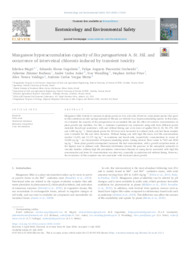Manganese hyperaccumulation capacity of Ilex paraguariensis A. St. Hil. and occurrence of interveinal chlorosis induced by transient toxicity.
Manganese hyperaccumulation capacity of Ilex paraguariensis A. St. Hil. and occurrence of interveinal chlorosis induced by transient toxicity.
Author(s): MAGRI, E.; GUGELMIN, E. K.; GRABARSKI, F. A. P.; BARBOSA, J. Z.; AULER, A. C.; WENDLING, I.; PRIOR, S. A.; VALDUGA, A. T.; MOTTA, A. C. V.
Summary: Manganese (Mn) toxicity is common in plants grown on very acid soils. However, some plants species that grow in this condition can take up high amounts of Mn and are referred to as hyperaccumulating species. In this study, we evaluated the capacity of Ilex paraguariensis to accumulate Mn and the effect of excessive concentrations on plant growth and nutrition. For this, a container experiment was conducted using soils from different parent materials (basalt and sandstone), with and without liming, and at six doses of applied Mn (0, 30, 90, 270, 540 and 1,080 mg kg 1). Clonal plants grown for 203 days were harvested to evaluate yield, and leaf tissue samples were evaluated for Mn and other elements. Without liming and with high Mn doses, leaf Mn concentrations reached 13,452 and 12,127 mg kg 1 in sandstone and basalt soils, respectively; concentrations in excess of 10,000 mg kg 1 are characteristic of hyperaccumulating plants. Liming reduced these values to 7203 and 8030 mg kg 1. More plant growth accompanied increased Mn leaf concentrations, with a growth reduction noted at the highest dose in unlimed soils. Elemental distribution showed Mn presence in the mesophyll, primarily in vascular bundles, without high Mn precipitates. Interveinal chlorosis of young leaves associated with high Mn concentration and lower Fe concentrations was observed, especially in sandstone soil without liming. However, the occurrence of this symptom was not associated with decreased plant growth.
Publication year: 2020
Types of publication: Journal article
Unit: Embrapa Forestry
Observation
Some of Embrapa's publications are published as ePub files. To read them, use or download one of the following free software options to your computer or mobile device. Android: Google Play Books; IOS: iBooks; Windows and Linux: Calibre.
Access other publications
Access the Agricultural Research Database (BDPA) to consult Embrapa's full library collection and records.
Visit Embrapa Bookstore to purchase books and other publications sold by Embrapa.

